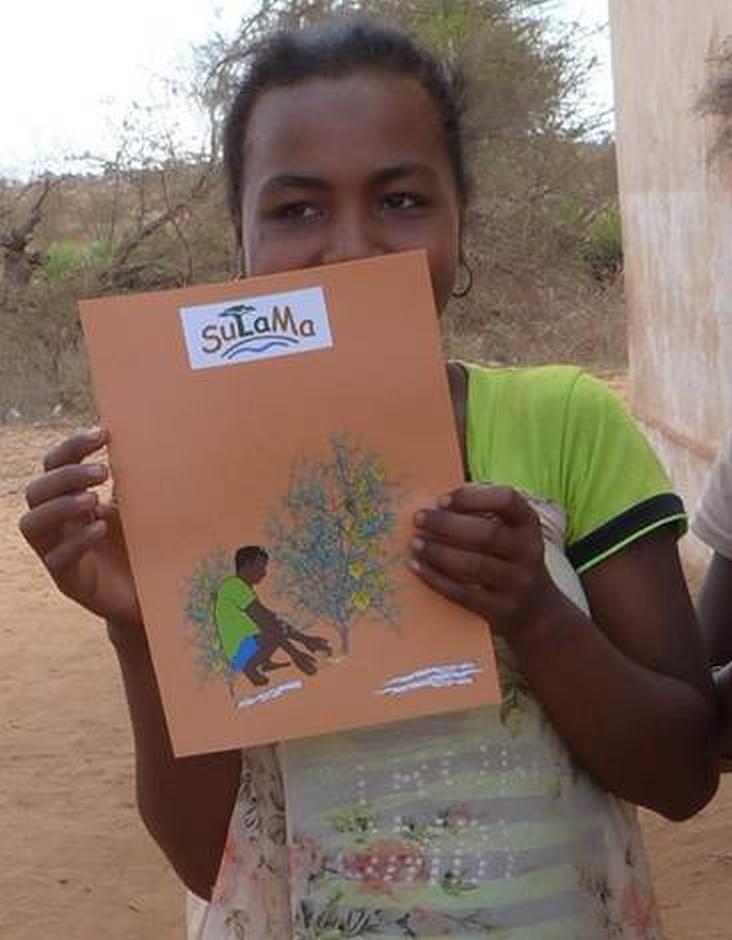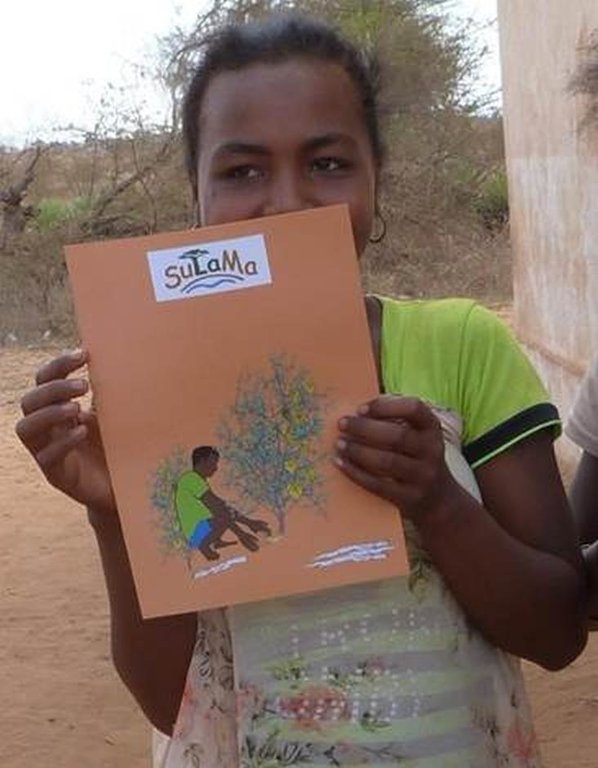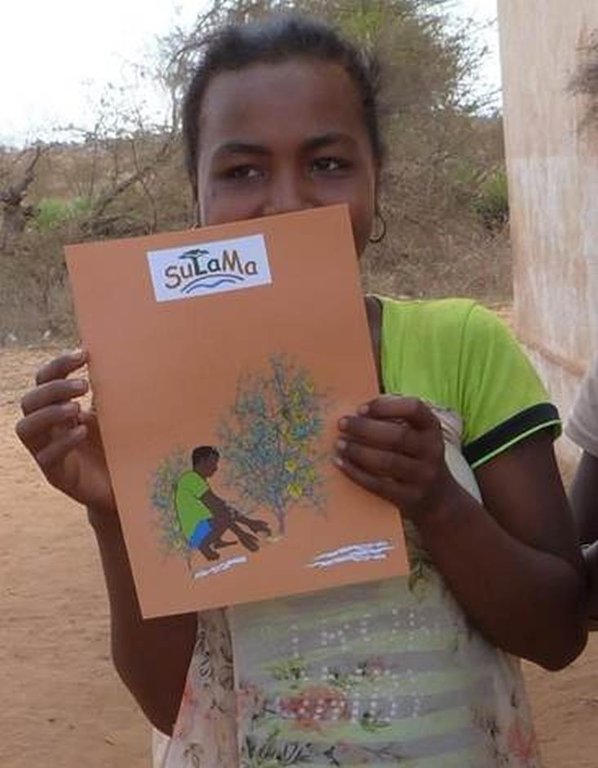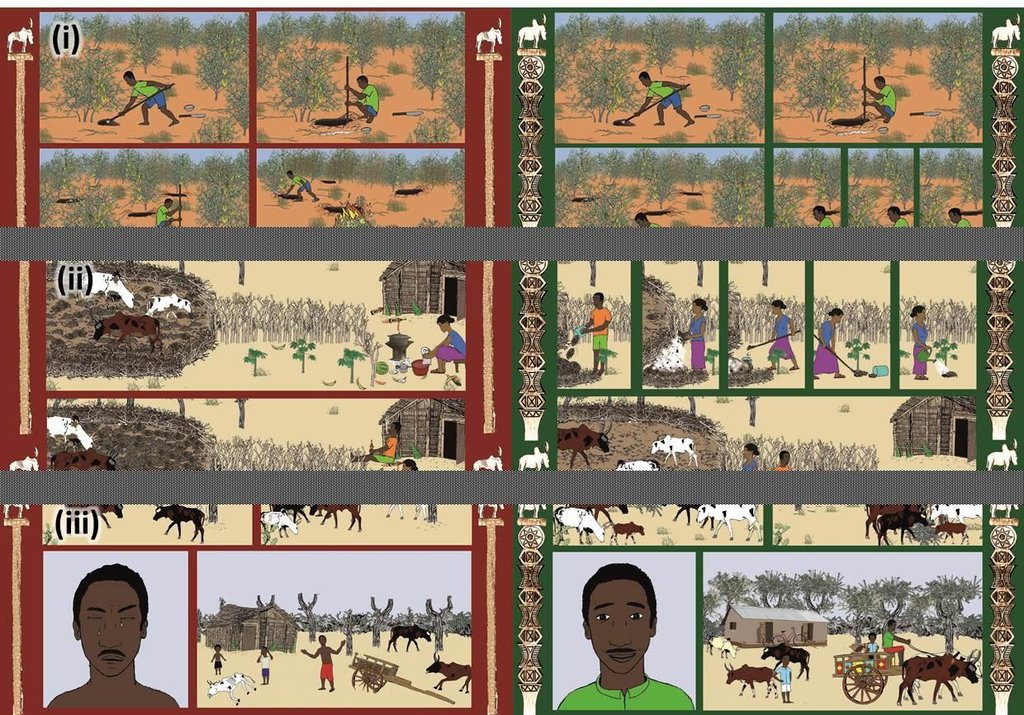Increasing environmental awareness using comic-style illustrations as a visual communication tool [Madagascar]
- Création :
- Mise à jour :
- Compilateur : Tobias Feldt
- Rédacteur : –
- Examinateurs : Fabian Ottiger, Deborah Niggli
approaches_2545 - Madagascar
Voir les sections
Développer tout Réduire tout1. Informations générales
1.2 Coordonnées des personnes-ressources et des institutions impliquées dans l'évaluation et la documentation de l'Approche
Spécialiste GDT:
Weiss David
mail@david-weiss.com
David Weiss Agrarcomics
Kirchstraße 18, D-37214 Witzenhausen http://david-weiss.com
Allemagne
Nom du projet qui a facilité la documentation/ l'évaluation de l'Approche (si pertinent)
Sustainable Landmanagement in south-western Madagascar (SuLaMa / GLUES)Nom du projet qui a facilité la documentation/ l'évaluation de l'Approche (si pertinent)
Book project: Making sense of research for sustainable land management (GLUES)Nom du ou des institutions qui ont facilité la documentation/ l'évaluation de l'Approche (si pertinent)
Universität Kassel - Allemagne1.3 Conditions relatives à l'utilisation par WOCAT des données documentées
Quand les données ont-elles été compilées (sur le terrain)?
01/10/2015
Le compilateur et la(les) personne(s) ressource(s) acceptent les conditions relatives à l'utilisation par WOCAT des données documentées:
Oui
1.4 Références au(x) questionnaire(s) sur les Technologies de GDT
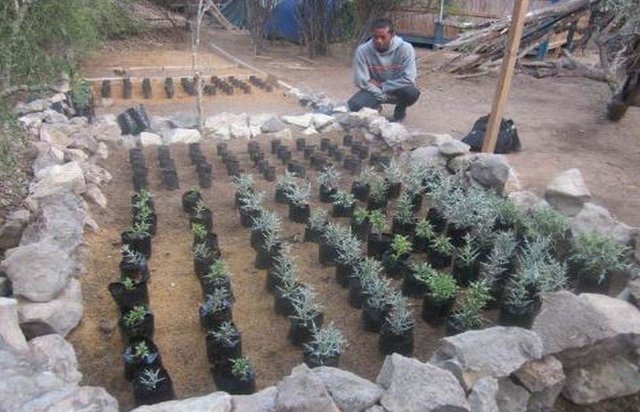
Sustainable propagation of the fodder tree Euphorbia stenoclada … [Madagascar]
Propagation of “samata” cuttings for long-term provision of supplementary livestock fodder to reduce the pressure on natural vegetation.
- Compilateur : Johanna Goetter
2. Description de l'Approche de GDT
2.1 Courte description de l'Approche
Communicating and transferring scientific results and recommendations about sustainable land management to local people
2.2 Description détaillée de l'Approche
Description détaillée de l'Approche:
Aims / objectives: The central aim of this approach was to increase environmental awareness in the Mahafaly region of southwestern Madagascar using visual communications tools. Comic-style illustrations were originally designed to communicate scientific recommendations on sustainable land management (SLM) and to ensure knowledge transfer from scientists to local people.
Methods: Visual communication, based on pictures, drawings, movies, sequential images and posters plays a vital role in countries where many people are illiterate. Another advantage is its easy reproduction in comparison to oral communication. It may also transfer knowledge where oral communication fails because of linguistic barriers or simply because complex narratives and messages are easier to explain visually than orally. In the context of a participatory research project to support SLM on the Mahafaly Plateau in southwestern Madagascar, comic-style illustrations of visual narratives were used to focus on environmental problems and SLM strategies. Since cross-cultural differences arise in “visual languages” globally, the visualization style needs to be carefully selected. Furthermore, misunderstanding of visual narratives may occur when objects are drawn not realistically enough, or if the statement is abstract or only presented from a scientific The central aim point of view. To avoid misinterpretation and increase readability and local acceptance, the style of comics was specifically designed for the conditions in rural Madagascar using a traditional Malagasy art style (sepulchre art in the form of “Aloalo” tomb sculptures). Comic illustrations were prepared to show the impact of different land use practices on the environment and local livelihoods using two contrasting stories/scenarios. The “red story” depicts a worst case scenario of unsustainable practices that are often applied by local inhabitants and the “green story” shows an example of a best case scenario based on an alternative, sustainable land management option recommended by scientific experts. To keep the stories simple and understandable, there was a focus on scientific key messages which can be easily transformed into visual narratives - and technical details were left aside.
Stages of implementation: The six year (2011-2016) transdisciplinary research consortium of Malagasy and German universities was initiated in the Mahafaly region of southwestern Madagascar in order to support sustainable land management (SuLaMa = Sustainable Land Management in southwestern Madagascar). Based on scientific research regarding the diversity and local use of forest resources and SLM practices in animal and crop husbandry, key messages and recommendations, which were easy to implement, were formulated by the scientific experts. Two examples of overused natural resources and one example of a neglected soil improvement practice were chosen for comic-style illustrations and transformed to visual narratives. These are (i) sustainable harvesting practice of wild yams (Dioscorea bemandry); (ii) composting of manure and its application to improve soil fertility and yields in home gardens; and (iii) sustainable utilization of the succulent tree Euphorbia stenoclada (called 'samata' in the local dialect) as supplementary forage for livestock. During an inception phase for the implementation of visual narratives in the study region, different drawing styles were tested and assessed to gather information on the local perception of art. Drawing styles showing the highest acceptance rate and readability were subsequently used to prepare the comics. The comics were printed on robust clay coated paper and handed out to local inhabitants during larger village workshops, where the different stories were presented and discussed.
2.3 Photos de l'approche
2.5 Pays/ région/ lieux où l'Approche a été appliquée
Pays:
Madagascar
Région/ Etat/ Province:
Atsimo-Andrefana (South-West Madagascar)
Autres spécifications du lieu :
Toliara II
2.6 Dates de début et de fin de l'Approche
Indiquez l'année de démarrage:
2015
Date (année) de fin de l'Approche (si l'Approche n'est plus appliquée):
2016
2.7 Type d'Approche
- fondé sur un projet/ programme
2.8 Principaux objectifs de l'Approche
The Approach focused mainly on SLM with other activities (sustainable land use, livestock husbandry, crop production, yams)
Comic-style illustrations were designed for environmental education purposes to communicate scientific results and recommendations on sustainable land management and ensure knowledge transfer from scientific experts to local people. It is the general aim of the approach to raise awareness for sustainable land use and environmental protection and therefore to improve both people's livelihoods and the efficiency in the use of natural resources.
The SLM Approach addressed the following problems: The approach area is characterized by low agricultural production, a lack of technical knowledge, low education level and conflicts over resource use.
2.9 Conditions favorisant ou entravant la mise en œuvre de la(des) Technologie(s) appliquée(s) sous l'Approche
normes et valeurs sociales/ culturelles/ religieuses
- entrave
People in the project area have a cultural reservation towards the utilization of animal dung, thus renouncing one of the fundamental principles for soil amelioration. At the same time, the declination of handling the animals' feces and therefore hardly ever cleaning their night enclosures strogly increases the risk of epizootic diseases and parasite infections.
Treatment through the SLM Approach: The comic drawings attempt to demonstrate how simple measures may have a sustainable impact in improving people’s livelihoods in many ways. They will at best be food-for-thought to reconsider culture-based practices that are not good SLM practice.
cadre juridique (régime foncier, droits d'utilisation des terres et de l'eau)
- entrave
With regard to the sustainable utilization of fodder trees, land ownership conflicts may arise as most of these trees around settlements stand on private ground – but without clear demarcation.
Treatment through the SLM Approach: Where currently there only exist single cactus plants or other hardly recognisable natural markings between plots, clear boundary lines between those plots could be illustrated as a good alternative in the respective comic.
The existing land ownership, land use rights / water rights hindered a little the approach implementation Some contents presented in the comic drawings, such as on the sustainable utilization of fodder trees, can conflict with land ownerships as most of these trees around settlements stand on private ground. Boundary lines between these plots, often only consisting of single cactus plants or other natural markings, may not be recognizable for outsiders but have to be included into the comics to avoid missunderstandings.
charge de travail, disponibilité de la main-d'œuvre
- entrave
Local people often do not see a direct benefit from higher workload e.g. by a more careful harvesting of forest products, the cleaning of livestock enclosures, or the utilization of manure for soil amelioration.
Treatment through the SLM Approach: The approach aims to show plainly the positive and sustainable impact of the alternative practices and the effect on people’s livelihoods.
autre
- entrave
The concept of some natural resources being finite is not very widespread among the local population.
Treatment through the SLM Approach: The approach may help local people to become more aware of this problem and to induce the
establishment of more sustainable land use practices.
3. Participation et rôles des parties prenantes impliquées dans l'Approche
3.1 Parties prenantes impliquées dans l'Approche et rôles
- exploitants locaux des terres / communautés locales
Crop and livestock farmers
Livestock related topics were addressed to male farmers as they are mainly involved in livestock husbandry.
- ONG
- gouvernement local
municipality, village
- gouvernement national (planificateurs, décideurs)
- organisation internationale
3.2 Participation des exploitants locaux des terres/ communautés locales aux différentes phases de l'Approche
| Participation des exploitants locaux des terres/ communautés locales | Spécifiez qui était impliqué et décrivez les activités | |
|---|---|---|
| initiation/ motivation | aucun | |
| planification | interactive | data surveys, questionnaires, group discussions |
| mise en œuvre | soutien extérieur | village workshops to present the comics and to explain the storylines. |
| suivi/ évaluation | interactive | stepwise evaluation and improvement of comic understanding and acceptance by land users and the community |
| Research | passive |
3.3 Diagramme/ organigramme (si disponible)
Description:
Extracts of three storylines on (i) yams harvesting, (ii) manure composting and (iii) the utilization of ‘samata’ (Euphorbia stenoclada)
Auteur:
D. Weiss
3.4 Prises de décision pour la sélection de la Technologie/ des Technologies
Indiquez qui a décidé de la sélection de la Technologie/ des Technologies à mettre en œuvre:
- principalement les spécialistes de la GDT, après consultation des exploitants des terres
Expliquez:
During the six-year term of the original project, researchers gained a deep inside into the daily routine and workflow of the local population. The technology approach was therefore based on this knowledge and aimed at some of the major problems identified.
Decisions on the method of implementing the SLM Technology were made by mainly by SLM specialists with consultation of land users
4. Soutien technique, renforcement des capacités et gestion des connaissances
4.1 Renforcement des capacités/ formation
Une formation a-t-elle été dispensée aux exploitants des terres/ autres parties prenantes?
Oui
Spécifiez qui a été formé:
- exploitants des terres
- personnels/ conseillers de terrain
Formats de la formation:
- zones de démonstration
- réunions publiques
4.2 Service de conseils
Les exploitants des terres ont-ils accès à un service de conseils?
Oui
4.3 Renforcement des institutions (développement organisationnel)
Des institutions ont elles été mises en place ou renforcées par le biais de l'Approche?
- oui, modérément
Spécifiez à quel(s) niveau(x), ces institutions ont été renforcées ou mises en place:
- local
Précisez le type de soutien:
- financier
- renforcement des capacités/ formation
- équipement
Donnez plus de détails:
Local schools can be equipped with material and practical training courses can be developed with the collaboration of teachers, village chiefs and elders.
4.4 Suivi et évaluation
Le suivi et l'évaluation font ils partie de l'Approche? :
Oui
Commentaires:
technical aspects were regular monitored by project staff through observations; indicators: Data on land use practices were collected.
technical aspects were regular monitored by project staff through measurements; indicators: Data on human well-being and social conventions (customs, traditions, rituals) were collected.
socio-cultural aspects were regular monitored by project staff, land users through observations; indicators: Comics were distributed to land users and discussed with representatives of 15 villages.
no. of land users involved aspects were ad hoc monitored by None through observations
Evaluation aspects were ad hoc monitored by project staff through observations; indicators: evaluation of understanding and acceptance of comics
There were several changes in the Approach as a result of monitoring and evaluation: The understanding of the comics, their acceptance and the possible implementation of the land use approaches still have to be investigated during a follow-up evaluation process. There were few changes in the technologies. This still needs to be investigated during the evaluation process.
There were few changes in the Technology as a result of monitoring and evaluation: This still needs to be investigated during the evaluation process.
4.5 Recherche
La recherche a-t-elle fait partie intégrante de l’Approche?
Oui
Spécifiez les thèmes:
- sociologie
- économie/ marketing
- écologie
- technologie
Donnez plus de détails et indiquez qui a mené ces recherches:
Research was carried out on-farm
5. Financement et soutien matériel externe
5.1 Budget annuel de la composante GDT de l'Approche
Si le budget annuel précis n'est pas connu, indiquez une fourchette:
- 2 000-10 000
Commentez (par ex. principales sources de financement/ principaux bailleurs de fonds):
Approach costs were met by the following donors: government (German Federal Ministry of Education and Research (BMBF)): 100.0%
5.2 Soutiens financiers/ matériels fournis aux exploitants des terres
Les exploitants des terres ont-ils reçu un soutien financier/ matériel pour la mise en œuvre de la Technologie/ des Technologies?
Oui
5.3 Subventions pour des intrants spécifiques (incluant la main d'œuvre)
- équipement
| Spécifiez les intrants subventionnés | Dans quelle mesure | Spécifiez les subventions |
|---|---|---|
| drawing material (pens and paper) | entièrement financé | |
Si la main d'œuvre fournie par les exploitants des terres était un intrant substantiel, elle était:
- volontaire
Commentaires:
Travel expenses for the field trip of the comic illustrator was covered by the project
5.4 Crédits
Des crédits ont-ils été alloués à travers l'Approche pour les activités de GDT?
Non
6. Analyses d'impact et conclusions
6.1 Impacts de l'Approche
This still needs to be investigated during the evaluation process.
This still needs to be investigated during the evaluation process.
Est-ce que l'Approche a amélioré les questions foncières et des droits d'utilisation qui entravent la mise en œuvre des Technologies?
- Non
- Oui, un peu
- Oui, modérément
- Oui, beaucoup
This still needs to be investigated during the evaluation process.
6.2 Principale motivation des exploitants des terres pour mettre en œuvre la GDT
- augmenter la production
- augmenter la rentabilité/ bénéfice, rapport coûts-bénéfices
- prestige, pression sociale/ cohésion sociale
- conscience environnementale
- well-being and livelihoods improvement
6.3 Durabilité des activités de l'Approche
Les exploitants des terres peuvent-ils poursuivre ce qui a été mis en œuvre par le biais de l'Approche (sans soutien extérieur)?
- oui
Si oui, décrivez de quelle manière:
Land users can implement the technologies presented in the comics without further help. However for additional applications, new case-specific comic drawings will have to be prepared as the land users may not be able to transmit messages about other practices.
6.4 Points forts/ avantages de l'Approche
| Points forts/ avantages/ possibilités du point de vue de l'exploitant des terres |
|---|
| Structured surveys carried out after the distribution of the material showed that local people understood and generally accepted the comic stories. |
| Points forts/ avantages/ possibilités du point de vue du compilateur ou d'une autre personne ressource clé |
|---|
| This approach has great potential for communication of any knowledge not only scientific. It should be further supported and widely used especially in rural areas with low literacy but not only there. Pictures have a great impact on peoples’ perception and messages can be easier memorized. |
| The more the pictures correspond with reality, the better is the “readability” and identification. The fewer the needless details shown, the better the recognition. |
| The environmental education material offers various possibilities of application, e.g. in schools or during village meetings. It can be used by the local communities over a long period of time. |
| As soon as an appropriate illustration style is found, various topics can be supplemented and more complex subjects can be depicted in greater detail. Individual comic strips may form the base for a more comprehensive but well understandable and adoptable compendium. |
6.5 Faiblesses/ inconvénients de l'Approche et moyens de les surmonter
| Faiblesses/ inconvénients/ risques du point de vue du compilateur ou d'une autre personne ressource clé | Comment peuvent-ils être surmontés? |
|---|---|
| Considerable investment and preparation is needed to implement comic-style illustration methods. Comic strips have to be provided in sufficient volume and quality, as reprinting is too expensive for local communities. | |
| In-depth knowledge and understanding of local traditions and practices is mandatory as apparently minor (incorrect) details and finesses may hamper the comprehensibility and acceptance of the comic strips. | |
| The design of comics that are both comprehensive and convertible by their contents for the local population requires a lot of time consuming preliminary work. If available, local artists and organizations should be called in and involved into this process to make sure, at the same time, that the approach can be carried on and developed by local stakeholders. |
7. Références et liens
7.1 Méthodes/ sources d'information
- visites de terrain, enquêtes sur le terrain
- interviews/entretiens avec les exploitants des terres
7.2 Références des publications disponibles
Titre, auteur, année, ISBN:
Andriamparany, J.N., 2015. Diversity, local uses and availability of medicinal plants and wild yams in the Mahafaly region of southwestern Madagascar.Andriamparany J.N., Brinkmann K., Whiele M., Jeannoda V., Buerkert A. (2015). Modelling the distribution of wild yam species in southwestern Madagascar using biotic and abiotic factorsFeldt, T., 2015. Interrelatedness of grazing livestock with vegetation parameters and farmers' livelihoods in the Mahafaly region, southwestern MadagascarFeldt, T., Schlecht, E., (2016). Analysis of GPS trajectories to assess spatio-temporal differences in grazing patterns and land use preferences of domestic livestock in southwestern MadagascarGoetter, J.F., Neudert, R., (accepted). New rules are not rules: privatization of pastoral commons and local attempts at curtailment in southwest MadagascarHanisch, S., 2015. Improving cropping systems of semi-arid southwestern Madagascar under multiple ecological and socio-economic constraintsWeiss, D. (2014). Visual communication: a promising approach in developing countries?
Disponible à partir d'où? Coût?
PhD thesis, University of Kassel, Germany
Titre, auteur, année, ISBN:
Andriamparany J.N., Brinkmann K., Whiele M., Jeannoda V., Buerkert A. (2015). Modelling the distribution of wild yam species in southwestern Madagascar using biotic and abiotic factors
Disponible à partir d'où? Coût?
Agriculture, Ecosystems and Environment 212, p. 38-48.
Titre, auteur, année, ISBN:
Feldt, T., 2015. Interrelatedness of grazing livestock with vegetation parameters and farmers' livelihoods in the Mahafaly region, southwestern Madagascar
Disponible à partir d'où? Coût?
PhD thesis, University of Kassel, Germany
Titre, auteur, année, ISBN:
Feldt, T., Schlecht, E., (2016). Analysis of GPS trajectories to assess spatio-temporal differences in grazing patterns and land use preferences of domestic livestock in southwestern Madagascar
Disponible à partir d'où? Coût?
Pastoralism: Research, Policy and Practice 6 (1).
Titre, auteur, année, ISBN:
Goetter, J.F., Neudert, R., (accepted). New rules are not rules: privatization of pastoral commons and local attempts at curtailment in southwest Madagascar
Disponible à partir d'où? Coût?
International Journal of the Commons
Titre, auteur, année, ISBN:
Hanisch, S., 2015. Improving cropping systems of semi-arid southwestern Madagascar under multiple ecological and socio-economic constraints
Disponible à partir d'où? Coût?
PhD thesis, University of Kassel, Germany
Titre, auteur, année, ISBN:
Weiss, D. (2014). Visual communication: a promising approach in developing countries?
Disponible à partir d'où? Coût?
Bachelor thesis, University of Kassel, Germany
Liens et modules
Développer tout Réduire toutLiens

Sustainable propagation of the fodder tree Euphorbia stenoclada … [Madagascar]
Propagation of “samata” cuttings for long-term provision of supplementary livestock fodder to reduce the pressure on natural vegetation.
- Compilateur : Johanna Goetter
Modules
Aucun module trouvé


